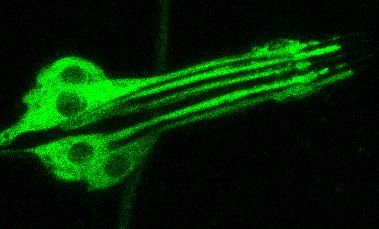Locomotion control with photopigments

Mechanoreceptors of the drosophila larva Photo: University of Göttingen
Animal photoreceptors capture light with photopigments. Researchers from the University of Göttingen have now discovered that these photopigments fulfill an additional function: They not only exist in eyes, but also in mechanoreceptors along the body, where they control body movements. The results were published in Neuron.
Coordinated locomotion requires mechanoreceptors that inform animals about their body movements. By analyzing locomotion in Drosophila fruit fly larvae, the scientists found that this locomotion control requires visual opsins, the visual photopigment proteins.
Without opsins, the mechanoreceptors no longer responded to mechanical stimuli – Drosophila larvae lacking visual opsin proteins were found to hardly crawl and to be unable to perform coordinated body movements.
“Within the mechanoreceptors, opsin proteins serve structural roles instead of detecting light,” explains Diego Giraldo, PhD student at Göttingen University’s Department of Cellular Neurobiology. “These opsins apparently organize cilia. Without them, the cilia degenerate and ion channels leak out from the cilia.”
According to the researchers, finding opsins in mechanosensory cells is evolutionarily not that surprising. Because the mechanoreceptors are closely related to photoreceptors, the new discovery seems to close an evolutionary gap.
“We always thought that the different photopigment proteins evolved to monitor different colors of light,” says Dr. Bart Geurten, one of the lead authors of the publication. “We now find that all these opsins occur together in mechanoreceptor cells, indicating that they are older than their use for color vision.”
That the mechanosensory roles of photopigments are indeed millions of years old is supported by recent work on vertebrates. How exactly opsins contribute to cilium maintenance is currently being investigated.
Original publication. Damiano Zanini et al. Proprioceptive opsin functions in Drosophila larval locomotion. Neuron 2018. Doi: 10.1016/j.neuron.2018.02.028.
Contact
Prof. Dr. Martin Göpfert
Georg-August-University of Göttingen
Faculty of Biology and Psychology
Department of Cellular Neurobiology
Julia-Lermontowa-Weg 3
37077 Göttingen
Phone +49 551 39-177955
Email: mgoepfe@gwdg.de
Internet: http://www.uni-goettingen.de/de/114662.html
Media Contact
All latest news from the category: Life Sciences and Chemistry
Articles and reports from the Life Sciences and chemistry area deal with applied and basic research into modern biology, chemistry and human medicine.
Valuable information can be found on a range of life sciences fields including bacteriology, biochemistry, bionics, bioinformatics, biophysics, biotechnology, genetics, geobotany, human biology, marine biology, microbiology, molecular biology, cellular biology, zoology, bioinorganic chemistry, microchemistry and environmental chemistry.
Newest articles

A universal framework for spatial biology
SpatialData is a freely accessible tool to unify and integrate data from different omics technologies accounting for spatial information, which can provide holistic insights into health and disease. Biological processes…

How complex biological processes arise
A $20 million grant from the U.S. National Science Foundation (NSF) will support the establishment and operation of the National Synthesis Center for Emergence in the Molecular and Cellular Sciences (NCEMS) at…

Airborne single-photon lidar system achieves high-resolution 3D imaging
Compact, low-power system opens doors for photon-efficient drone and satellite-based environmental monitoring and mapping. Researchers have developed a compact and lightweight single-photon airborne lidar system that can acquire high-resolution 3D…





















